
Aspera faspex Administrator Guide
All Platforms
Version 1.6.1
- Chapter 1 Introduction
- Chapter 2 Getting Started
- 2.1 faspex Overview
- 2.2 Manage your faspex Account
- Chapter 3 Setting Up
- 3.1 Configure faspex Server and Central Server
- 3.2 Configure Active Directory
- 3.3 Configure Multi-Server
- 3.4 Customize the Send Form to Include Metadata Fields
- Chapter 4 Administration
- 4.1 faspex Users
- 4.2 faspex Workgroups
- 4.3 Packages
- 4.4 Post-Processing
- 4.5 Email Notifications
- Chapter 5 Transfer Files
- 5.1 Download Packages
- 5.2 Send Packages
- Appendix 1 Restart faspex
- 2 The Log Files
- 3 Reset the faspex Admin Password
- 4 faspex Commands
- Reference
1. Introduction
Aspera faspex is a file exchange application built upon Aspera Enterprise Server as a centralized transfer solution. With a web-based graphical user interface, faspex offers more advanced management options for fasp high-speed transfer to match your organization's workflow. faspex provides the following features:
- fasp™ transport server
- Installed upon the Enterprise Server, a transport server that handles fasp™ connections.
- Web/Email-based Interface
- Simple web and email interface for exchanging files and directories.
- Package Forwarding
- Users can forward packages on the server to others without re-uploading.
- Permission Management
- Manage user permissions through workgroup assignment or direct-configuration.
- Post-Processing
- Execute custom scripts after a transfer when certain conditions are met.
- Email Notification
- Customizable Email Notification of faspex events such as receiving a package.
- Active Directory
- Integration of your organization's Active Directory users and groups with faspex.
- Multi-Server
- Multiple faspex servers can be configured to work together.
The most up-to-date documentation can be found at http://asperasoft.com/support/documentation/faspex.
For further assistance, please contact us at http://asperasoft.com/support.
2. Getting Started
2.1 faspex Overview
2.1.1 faspex Transfer Overview
The faspex Transfer is illustrated step-by-step in Figure 1:
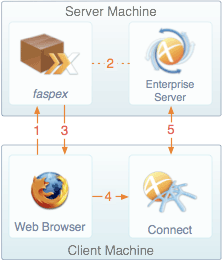 Figure 1.
Figure 1.
|
- User opens faspex website through web browser. faspex website will trigger the Aspera Connect browser plugin on the client's computer.
- When the user successfully logs in, faspex communicates with Aspera Enterprise Server to acquire the file and directory information.
- faspex returns either the file listing or the upload screen to the client.
- When the user clicks on a file's download link, or initiates a file upload, the browser passes the transfer information to the Aspera Connect.
- Once Aspera Connect receives the transfer information, it establishes a connection with the server's Enterprise Server and starts the file transfer.
|
faspex menu includes six options to administrators:

- Send
- Send a file package.
- My Received
- List all the file packages you have received.
- My Sent
- List all the file packages you have sent.
- Workgroup Packages
- List all the file packages sent to your workgroups.
- Preferences
- Configure your account preferences.
- Server Admin
- Configure and manage your faspex Server.
2.2 Manage your faspex Account
Follow these steps to log in and manage your faspex user account:
- Step 1 Install Aspera Connect
-
faspex requires having Aspera Connect installed on your computer to start transfers. You can download it at http://asperasoft.com/connect.
You cannot transfer files using faspex if you are running on the machine that hosts it.
- Step 2 Log in faspex
-
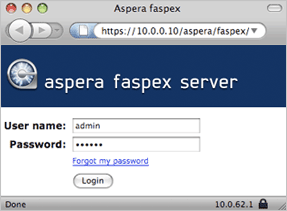
|
To start faspex, bring up a web browser and enter faspex's address. For example:
- URL: https://10.0.0.10/aspera/faspex
- Username: admin
- Password: aspera
|
- Step 3 Modify the account information
-
When logged in, go to Preferences from the faspex menu. You can change the following info:
- E-mail Settings
-
- E-mail address
The Email address to receive faspex notifications.
- E-mail me when I receive a package
Check to have faspex notify you of new packages through email.
- E-mail me when someone first downloads a package I sent.
Check to receive notification when the package you sent is first downloaded by the recipient.
- Lists
-
- Max row per page
Set how many rows to display in one faspex page.
- Change Password
-
- New Password/ Confirm Password
Enter the new password in both fields, then click Update Password.
It is strongly recommended to change the default password.
3. Setting Up
To configure faspex, go to Server Admin from the faspex menu. The following sections cover the server-related configurations.
3.1.1 faspex Server Configuration
Go to Server Admin > faspex Server. You can find the configuration options for the faspex web application:
- Address and Ports
-
- Server's external address or name
Display the faspex Server's IP address or domain name. Should you need to change it, refer to Appendix 3. faspex Commands and use the proper command to change the address.
- HTTP Port
Display the port number for HTTP connection.
- HTTPS Port
Display the port number for Secure HTTP (HTTPS) connection.
- Enable alternate address
Specify an alternative address. When checked, enter the server's address in the specified field.
- Display Settings
-
Date display format:
Enter the date format that faspex uses. The following list shows the variables can be used, the display examples, and the their description:
- %a
-
Sun
The abbreviated weekday name.
- %A
-
Sunday
The weekday name.
- %b
-
Jan
The abbreviated month name.
- %B
-
January
The month name.
- %d
-
01~31
Day of the month.
- %j
-
001~366
Day of the year.
- %m
-
01~12
Month of the year.
- %y
-
09
The abbreviated year.
- %Y
-
2009
The year.
The date display format examples:
- %A %B %d, %Y
- Sunday July 01, 2009
- %m/%d/%y
- 07/01/09
- %Y-%j
- 2009-183
- Package Files
-
-
Package Directory
Display the directory that faspex uses to store all the file packages. Refer to Appendix 3. faspex Commands if you need to change the package directory.
-
Package path prefix
The prepended string to the uploaded packages' directory pathname. For example, if the string PKG - is used, an uploaded package named textFiles will be stored in the path PKG - textFiles.
-
Automatically delete packages
When checked, uploaded packages will be deleted from server automatically after the specified number of days.
- Security
-
-
Session timeout
Sessions will timeout after the specified number of minutes of inactivity.
-
Deactivate users
Deactivate the user account when the login attempts fail under the specified circumstance.
-
Prevent concurrent login
When checked, users can only be logged in from one client at a time.
-
Use strong passwords
Require new user passwords to contain at least one letter, one number, and one symbol; existing passwords will remain valid.
-
Use Encryption-at-Rest
When checked, users will be required on upload to enter a password to encrypt the files on the server.
-
Allow sending packages to outside email addresses
When checked, packages can be sent to people not set up as faspex users. Additional options:
- Package link expires
When checked, the package link sent to an outside email address does not remain valid forever:
- Expire after:
Number of days before package link expires.
- Expire after successful download:
When checked, package is only downloadable once.
- Announcements
-
Message
Enter an announcement message to display on the login screen for all users (e.g. System maintenance schedule)
- SOAP
-
faspex SOAP listener URI
The address for Aspera Central to connect to.
(default: http://127.0.0.1:3000/direct_aspera_observer/api)
3.1.2 Aspera Central Server
Go to Server Admin > Aspera Central Server for fasp™ transport options:
- General
-
-
SSH TCP port
Set the TCP port for SSH connection sessions. (Default: 22)
-
fasp UDP port
Set the UDP port for fasp file transfers. (Default: 33001)
-
Server external address or name
The faspex Server's IP address or domain name.
-
Enable alternate address
If it is impossible to set up a fully qualified domain name that resolves to the appropriate address, you can enable this feature to set up a secondary address for the faspex server. All Email notifications and links will be replaced. When checked, enter the following information:
- Address or name
Enter the alternate address.
- Request client address
If the client's address matches this, assign the alternate address.
- Requested server address or name
If the requested server address matches this, assign the alternate address.
- If the user is access the faspex server from internal (192.168.1.* subnet), use the faspex server's internal IP address (192.168.1.111):
- Server's external address or name:
- faspex.mycompany.com
- Address or name:
- 192.168.1.111
- Requesting client address:
- 192.168.1.*
- Requested server name or address:
- <blank>
- If the user is accessing the faspex server with url 'https://faspex.mycompany.com', use this address instead of IP address:
- Server's external address or name:
- 192.168.1.111
- Address or name:
- faspex.mycompany.com
- Requesting client address:
- <blank>
- Requested server name or address:
- faspex.mycompany.com
- Transfer Options
-
- Enable HTTP fallback
Check this option to enable the HTTP Fallback feature.
- Encrypt transfers
Encrypt all transfers using AES-128 method.
- Default User Transfer Settings
-
-
Initial Transfer Rate
Specify the default transfer rate for all fasp™ transfers on faspex. Enter the value in both Upload and Download. To disable the user's control of minimum transfer rate and transfer policy, check the option Lock minimum rate and policy.
-
Maximum Allowed Rate
Specify the maximum transfer rate allowed for all fasp™ transfers on faspex. Enter the value in both Upload and Download.
- Server-to-Server Relay Transfer Settings
-
If you have more than one faspex server in your organization and have faspex's server-to-server relay set up, specify both the outgoing and incoming bandwidth between servers.
- SOAP Connection to Central
-
If faspex and Aspera Enterprise Server are not running on the same machine, you can use the following options to configure the SOAP connection between the Aspera Central on Enterprise Server and faspex:
- Protocol
The protocol for SOAP connection. (Default: http)
- Server Address
Specify the address of the machine that runs Aspera Enterprise Server. (Default: localhost, Aspera Central is on the same machine)
- SOAP Port
Specify the port for SOAP connection. (Default: 40001)
- Full SOAP URI
Display the SOAP URI.
- Aspera Connect Version
-
- Warn if out of date
When checked, warn the users to install the minimum Connect version specified in the text fields, in order to enable certain faspex features.
- Enforce minimum version
When checked, faspex would disallow transfers when the user's Connect version is older than the one specified in the text fields.
faspex can be configured to import, sync, and authenticate users and groups from Active Directory. This requires connectivity to an Active Directory domain controller or global catalog.
To configure the Active Directory support, follow these steps:
- Step 1 Modify the faspex.yml file
-
On the machine that runs the faspex Server, use a text editor to open the file:
- 32bit XP/2003
- C:\Program Files\Aspera\Faspex\config\faspex.yml
- 64bit XP/2003
- C:\Program Files (x86)\Aspera\Faspex\config\faspex.yml
- Linux
- /opt/aspera/faspex/config/faspex.yml
The following is a configuration example. Each entry is explained in the following table:
...
EnableActiveDirectory: yes
ActiveDirectoryOptions:
UseADProxy: no
ADProxyPort: 7000
ADServerAddress: dca.myCompany.com
ADServerPort: 389
ADServerTreebase: 'dc=myCompany,dc=com'
ADServerUsername: 'CN=aspera aspera,CN=Users,DC=myCompany,DC=com'
ADServerPassword: "serverPassword"
ADUserIdentifier: samaccountname
...
- EnableActiveDirectory
- Set to yes to enable the Active Directory support.
- UseADProxy
- Use a proxy server to communicate with the Active Directory server.
Contact Aspera Support for proxy configuration assistance.
- ADProxyPort
- Specify the proxy port number.
- ADServerAddress
- The Active Directory Server's address.
- ADServerPort
- The Active Directory Server's port number. By default, LDAP uses 389, and Global catalog uses 3268.
- ADServerTreebase
- The search treebase. E.g. dc=myCompany,dc=com for myCompany.com
- ADServerUsername
- The Active Directory user name. If your Active Directory server is configured to allow anonymous lookups, leave this field blank.
- ADServerPassword
- Enter the Active Directory user's password.
- ADUserIdentifier
- Enter the LDAP attribute you wish to use as the faspex account name for Active Directory-imported users. (E.g. samaccountname, mail)
The options under ActiveDirectoryOptions should be indented correctly. (E.g. two spaces)
- Step 2 Restart the faspex Services
-
Restart the faspex services to apply the Active Directory settings:
- Windows
-
Open Command Prompt (Start > All Programs > Accessories > Command Prompt), enter the command to navigate into the faspex directory:
- 32bit
-
> cd "C:\Program Files\Aspera\Faspex"
- 64bit
-
> cd "C:\Program Files (x86)\Aspera\Faspex"
In the directory, execute the commands:
> asctl faspex:restart
- Linux
-
In Terminal, execute the commands:
$ /opt/aspera/faspex/bin/asctl faspex:restart
- Step 3 Manage Active Directory groups
-
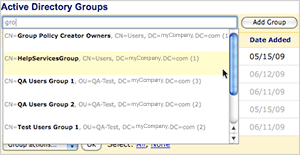 |
Open the faspex on your web browser. Navigate into the Server Admin > Active Directory. In the Active Directory Groups panel, enter the Active Directory group you wish to add. Typing more than three characters brings up the group list with matching keywords. Click Add Group |
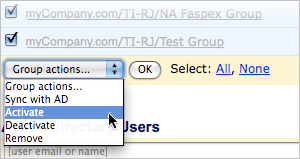 |
Use the options below to edit the Active Directory groups. You can synchronize the info, activate, deactivate, or remove the groups through it. Use the checkbox to group-edit the selected items. |
faspex will not search for the Active Directory groups recursively to import users. If a group A contains another group group B, importing the group A doesn't import the users in the group B.
- Step 4 Manage Active Directory users
-
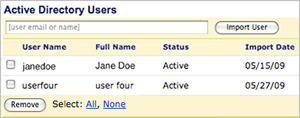 |
If you wish to add individual Active Directory users, enter the user's name in the Active Directory Users panel. Same as the Active Directory Groups panel, type in three or more characters to see the list. |
- Step 5 Identify the Active Directory users
-
 |
When the Active Directory groups or users are added, you should see the Active Directory users in the Server Admin > Users screen. The Active Directory users are indicated with a Windows icon. |
You can set up server relay between multiple faspex servers. When configured, the users on one server can send files to the user on the other one, and you can create Home Server Rules to auto-assign users to a specific faspex server. The packages being transferred between users on different home servers will be auto-forwarded through the faspex server-to-server relay.
In the multi-server environment, you need to assign a faspex server as the master, and the other faspex servers as the slaves. To set it up, follow these steps:
- Step 1 Modify the slave faspex server's faspex.yml file
-
On the computer that you wish to configure as the slave faspex server, open the file faspex.yml:
- 32bit XP/2003
- C:\Program Files\Aspera\Faspex\config\faspex.yml
- 64bit XP/2003
- C:\Program Files (x86)\Aspera\Faspex\config\faspex.yml
- Linux
- /opt/aspera/faspex/config/faspex.yml
Locate the following options and use the underlined values:
...
EnableRemoteUserAdministration: yes
AllowedRemoteUserAdministrationIPs:
- 10.0.0.5
...
- EnableRemoteUserAdministration
- Use the value yes to enable this server as the slave.
- AllowedRemoteUserAdministrationIPs
- Enter the master faspex server's IP address.
- Step 2 Restart the slave server's faspex Services
-
Restart the faspex services to apply the multi-server settings:
- Windows
-
Open Command Prompt (Start > All Programs > Accessories > Command Prompt), enter the command to navigate into the faspex directory:
- 32bit
-
> cd "C:\Program Files\Aspera\faspex"
- 64bit
-
> cd "C:\Program Files (x86)\Aspera\faspex"
In the directory, execute the commands:
> asctl faspex:restart
- Linux
-
In Terminal, execute the commands:
$ /opt/aspera/faspex/bin/asctl faspex:restart
- Step 3 Add the slave server in the faspex Server Admin
-
On the master faspex server, go to Server Admin > Multi-Server. Click the Add New Server and enter the slave faspex Server's info. Click Create when done:
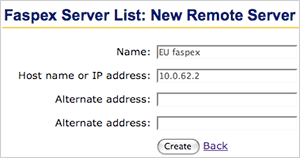 |
- Name
- The slave server's name.
- Host name or IP address
- The slave server's address.
- Alternate address
- Enter the alternate address, if any.
|
- Step 4 Set up the Home Server Rules
-
In the multi-server environment, you can set up rules to determine which server the user should connect to. Go to Server Admin > Multi-Server > Home Server Rules. Click Create New to begin. Click Create when finished.
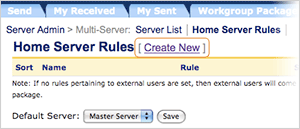
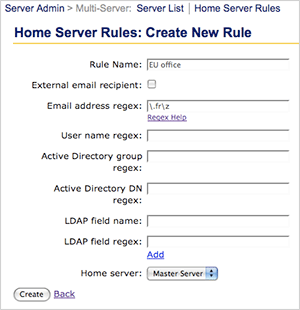
|
- Rule Name
- Enter a name for this rule.
- External email recipient
- Check the option to specify a rule with regular expression for external email addresses.
- Email address regex
- Use regular expression to specify certain email address.
- User name regex
- Use regular expression to specify certain user names.
- Active Directory group regex
- Use regular expression to specify certain Active Directory group.
- Active Directory DN regex
- Use regular expression to specify certain Active Directory DN.
- LDAP field name
- Specify a LDAP field to set up the rule.
- LDAP field regex
- Use regular expression to specify certain value in the chosen LDAP field.
- Home server
- Select a home server for the users that applies to this rule.
|
- Step 5 Set the server-to-server relay transfer rate
- In the multi-server environment, the packages being transferred between users on different home servers will be automatically forwarded through the server-to-server relay. To specify the transfer rate, go to Server Admin > Aspera Central Server. Locate the Server-to-Server Relay Transfer Settings section and enter the outgoing and incoming transfer rates.
You can add additional input fields and select menus into the Send form, creating the metadata fields that a sender can fill for any new package they are sending. The metadata will appear in the sent packages' description.
To configure the metadata fields, open the faspex.yml in the following location:
- 32bit XP/2003
- C:\Program Files\Aspera\Faspex\config\faspex.yml
- 64bit XP/2003
- C:\Program Files (x86)\Aspera\Faspex\config\faspex.yml
- Linux
- /opt/aspera/faspex/config/faspex.yml
Locate the Metadata: section in this file. If it is not present, add a top-level entry named Metadata:. The following is a metadata configuration example:
...
Metadata:
- name: Department # The field' label, starting with a hyphen.
type: select # The field type. select / input / textarea.
require: yes # Does this field requires value? yes / no.
choices: # List choices if the type is select.
- Administration # Each option starts with a hyphen.
- Marketing
- Sales
- Others
- name: Ref. No. # Another field
type: input
require: no
Notice the indentation in this example. Each entry should be formatted accordingly. (E.g. two spaces for another level)
The following table lists all options under the Metadata:. All options are required, except the choices that is only required when use the type select. You can add multiple sections for more fields.
- - name: text string
- The field's label. This name will appear to the user.
- type: select / input / textarea
- The type of the metadata field. This option accept three valid values:
- select A drop-down menu.
- input A single-line input box.
- textarea A multi-line input box.
- require: yes / no
- If the value is yes, the user will not be able to send the package without supplying a value.
- choices: text strings For type select only
- Enter a list of choices for the select drop-down menu. Each entry should start with a hyphen (-).
When finished modifying the faspex.yml, follow the instructions for your platform to restart the faspex services to apply the settings. On Windows, execute these commands in the Command Prompt (Start > All Programs > Accessories > Command Prompt):
- 32bit Windows
-
> cd "C:\Program Files\Aspera\faspex"
> asctl faspex:restart
- 64bit Windows
-
> cd "C:\Program Files (x86)\Aspera\faspex"
> asctl faspex:restart
- Linux
-
$ /opt/aspera/faspex/bin/asctl faspex:restart
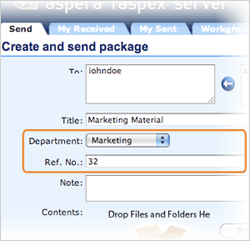 |
When successfully configured, you should find the additional fields in the Send screen.
|
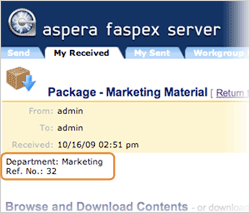 |
When the package is sent, the metadata will be shown on top of a package's description. area.
|
4. Administration
4.1 faspex Users
A faspex user is a login account for Aspera faspex and consists of specified permissions. You can modify the following user permissions to implement faspex into your organizational workflow:
- Download packages
- Upload packages
- Forward packages
- Send packages to external email
- Send packages to all faspex users instead of only your workgroup members
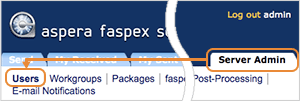
|
To access all faspex user management options, go to Server Admin in the faspex menu, and locate the Users tab. The following tasks are performed under this page.
|
4.1.1 Create a new user account

|
To create a new user account, click the Create New under the Users tab.
The following table contains all options in the Create New User form. When finished, click Create:
|
- Account Details
-
- Login (Required)
Enter the account's login name.
- Administrator
Check this option if this is an administrator account.
- Password (Required)
Enter the account's password. You can enable the Use strong password option in the faspex Server configuration to require a more secured combination. Refer to 3.1 Configure faspex Server and Central Server.
- Confirm Password (Required)
Repeat the account's password.
- Password expires
Check this option to expire the password every specified number of days.
- Account active
Check this option to enable this account.
- Account expires
Check this option to expire the account on the specified date.
- Comments
Enter the account's comments.
- User Permissions
-
- Package Uploads
Allow the user to upload file packages.
- Package Downloads
Allow the user to download file packages.
- Package Forwarding
Allow the user to forward file packages he or she received to other users. The package will be made accessible to the forwarded users on faspex.
- Sending to external email
Allow the user to send a download link to external emails.
- Sending to all faspex users
Allow the user to send file packages to all faspex users, as opposed to only able to send packages to the user's workgroup members.
- Allowed IP address for login
Specify the accepted IP address of the computer which the user uses to log in faspex. Wildcard (asterisk, *) can be used in this option, such as 192.168.10.*. To allow multiple IP addresses, use commas to separate.
- Allowed IP address for download
Specify the user's IP address permitted to download file packages. Wildcard (asterisk, *) can be used in this option, such as 192.168.10.*. To allow multiple IP addresses, use commas to separate.
- Allowed IP address for upload
Specify the user's IP address permitted to upload file packages. Wildcard (asterisk, *) can be used in this option, such as 192.168.10.*. To allow multiple IP addresses, use commas to separate.
- Personal Details
-
- First Name (Required)
Enter the user's first name.
- Last Name (Required)
Enter the user's last name.
- E-mail (Required)
Enter the user's e-mail address. This e-mail will be used to receive the faspex E-mail notifications.
To modify the E-mail template, refer to 4.5 E-mail Notifications.
- E-mail cc: list for "package received" notifications
Enter the emails that you want to copy the user's faspex notifications.
- Transfer Settings
-
- Overwrite default settings
Check this option to specify this user account's transfer settings. When checked, specify the Initial Transfer Rate and the Maximum allowed rate. For default settings, refer to 3.1 Configure faspex Server and Central Server, Aspera Central Server Configuration section.
- Welcome E-mail
-
- Send welcome message
Check this option to send a faspex welcome E-mail to the user
To modify the E-mail template, refer to 4.5 E-mail Notifications.
- Include password
Include this account's password in the welcome E-mail.
4.1.2 Manage user accounts

|
To manage existing user accounts, go to Server Admin from the faspex menu, and click Users. Click a login name to modify its settings.
|

|
The maximum user accommodation in faspex is restricted by the license. To review the account usage, find the faspex account usage. at the upper-right of the user listing.
|
4.2 faspex Workgroups
faspex uses workgroups to manage users' permissions. To access all faspex workgroup management options, go to Server Admin in the faspex menu, and locate the Workgroups tab. The following tasks are performed under this page.
4.2.1 Create a New Workgroup
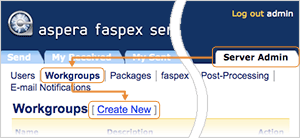
|
To create a new workgroup, go to faspex menu's Server Admin > Workgroups and click Create New.
The following table contains all options in the Create New Group form. When finished, click Create:
|
- Workgroup Details
-
- Name (Required)
Enter the workgroup's name.
- Description
Type in the workgroup's description.
- Workgroup Permissions
-
- Workgroup Type Select the workgroup type among the four options:
1. Dropbox
All faspex users (User1, User2 and User3) can upload file packages to the dropbox workgroup, regardless of the user's membership.
Members of this workgroup (User1 and User2) can download files from it.
|
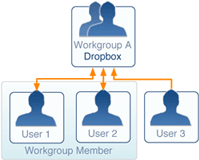
|
|
2. Members-Only
Only members of this group (User1 and User2) can upload file packages to the members-only workgroup.
Members of this workgroup (User1 and User2) can download files from it.
|

|
|
3. Moderated
Only the faspex administrators or this workgroup's administrators (User1) can upload file packages to the moderated workgroup.
Members of this workgroup (User1 and User2) can download files from it.
|
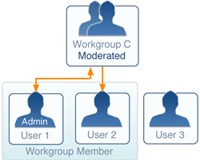
|
|
4. Restricted
No one can upload file packages to the restricted workgroup.
Members of this workgroup (User1 and User2) can download file packages from it.
|
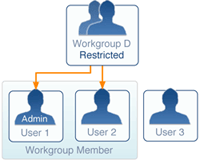
|
- Sending to Other Members
Select the workgroup's access to other members permissions:
1. Full
This permission setting allows all workgroup members to send file packages to other individuals in the same workgroup.
|
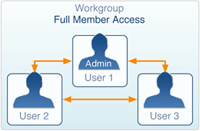
|
2. Workgroup Admin-Only
In this permission setting, workgroup members can only send file packages to the workgroup administrator, and the workgroup administrator cannot send to workgroup members.
|
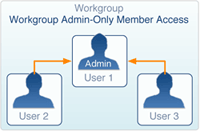
|
3. Restricted
In this setting, all workgroup members cannot send file packages to other individual workgroup members.
|
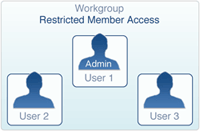
|
- Member Management
-
This section defines the workgroup administrator's management permissions. If both options are un-checked, this workgroup 's administrator will not have permissions to add or remove members.
- Add/remove existing users as members
The workgroup administrator can add or remove existing faspex users.
- Create/remove new users as members
The workgroup administrator can add or remove new faspex users.
- Add/remove Active Directory groups as members
The workgroup administrator can add or remove Active Directory groups.
4.2.2 Manage Workgroups
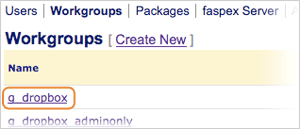
|
You can edit the existing groups by going to the Server Admin > Workgroups, and clicking the name of the workgroup to edit.
|
4.3 Packages
All packages sent through faspex will be stored on the faspex server, and the package files will be kept on the server for a certain number of days depending on the settings.
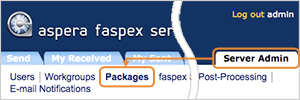
|
To manage the packages, go to faspex menu's Server Admin -> Packages.
The following diagram shows all items in this page:
|
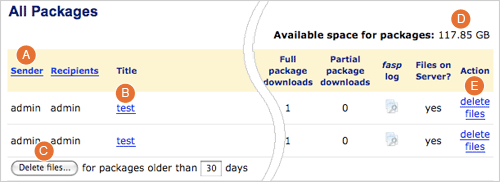
- A Header (Sender/Recipient...)
- Click to sort by the sender or recipient.
- B Package Title
- Click to browse the package.
- C Delete files
- Click to delete the packages older than the specified days.
- D Available space for packages
- The available disk space on the faspex server.
- E delete files
- Delete files in the package.
To view a package's information, click a package title. The general items in the page is shown below:
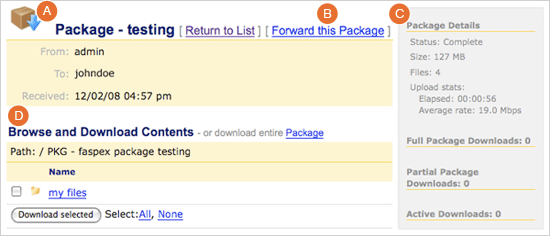
- A Download Icon
- Click the icon to download the complete package.
- B Forward this Package
- Click to forward this package if your account has proper permission.
- C Details
- This box shows the package's information and download activity.
- D Browse and
Download Contents
- Click to navigate into the folders contained in this package, and select individual files, click Download Selected to download only selected files.
4.4 Post-Processing
faspex allow the administrator to specify custom scripts to be executed automatically on the package when a package completes uploading, such as virus checking, moving files, and create backup.
The post-processing uses a set of filtering options to determine when to execute the customized scripts. faspex can execute shell scripts and Windows batch scripts, you can use the pre-defined environment variables to set up the scripts.
4.4.1 Prepare the Script
To set up the post-processing, a script should be generated and placed on the machine that runs faspex.
When the script is created, store it in the server that runs the faspex. Prepare the script's full path to configure the post-processing in faspex.
The following environment variables can be used in the script, use the variables in the script's variable form, for example the variable faspex_pkg_directory will be available as $faspex_pkg_directory in shell scripts, and %faspex_pkg_directory% in Windows batch:
- faspex_pkg_directory
- Storage directory of the package
- faspex_pkg_name
- Title of the package
- faspex_pkg_note
- Note of the package
- faspex_pkg_id
- Id of the package
- faspex_recipient_list
- Comma-separated list of recipients (e.g. "admin, johndoe")
- faspex_recipient_count
- Number of recipients (e.g. "3")
- faspex_recipient_i
- Name of the recipient (i starts at "0")
- faspex_sender_id
- Id of the sender
- faspex_sender_name
- Name of the sender
- faspex_sender_email
- E-mail of the sender
- faspex_pkg_total_bytes
- Size of the package in bytes
- faspex_pkg_total_files
- Number of files in the package
- faspex_pkg_uuid
- uuid of the package
4.4.2 Configure the Post-Processing

|
To add a post-processing script, go to the Server Admin from the faspex menu, and click Post-Processing. Click Create New from the page.
Each option in the Add New Script form:
|
- Script to run
-
- Execution criteria
-
All specified criteria must match the uploaded package's attributes for the script to be run on that package. All options in this section are optional. When the Exact match is checked, the package attribute has to match the specified criterion exactly for the script to be run.
- Package name
Execute when the package name matches the string.
- Sender name
Execute when the sender name matches the string.
- Sender email
Execute when the sender email matches the string.
- Recipient name
Execute when the recipient name matches the string.
- Recipient email
Execute when the recipient email matches the string.
- Package note
Execute when the package note matches the string.
- Package date
Execute when the package date falls into the determined range.
- Package size
Execute when the package size falls into the determined range.
- Package file count
Execute when the package file count falls into the determined range.
4.5 E-mail Notifications
faspex generates E-mail messages automatically to notify the newly created accounts and delivered packages.
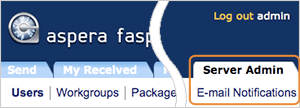
|
To configure, go to Server Admin from the faspex menu and click the E-mail Notifications.
|
The Email Notifications tab contains a Configuration and five templates. First click the Configuration to set up the email server.
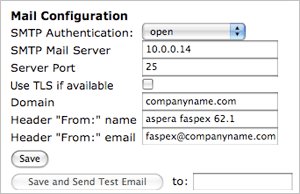
|
faspex supports two types of SMTP authentication options: open and login.
To debug the mail configuration, Enter your email address in the field next to the button Save and send test email and click the button.
|
4.5.2 Modify the E-mail Templates
There are five email templates for different purposes: Welcome, Forgot Password, Package Received, Package Downloaded, and Workgroup Package. All templates use the same editing interface and only vary in content, we will use Welcome template as an example. Under Server Admin > Email Notifications click Welcome, you will see the following template preview:
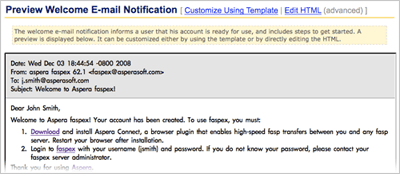
|
The email notifications can be modified through template mode or HTML code. Click Customize Using Template or Edit HTML to edit in the selected mode.
The following variables can be used to compose the specific email template:
|
- Welcome
-
- USER_NAME
- Full name of the e-mail recipient.
- SERVER_ADDRESS
- Name or IP of the faspex server.
- LOGIN
- Login name of the e-mail recipient.
- Forgot Password
-
- USER_NAME
- Full name of the e-mail recipient.
- LOGIN
- Login name of the e-mail recipient.
- Package Received
-
- SENDER_NAME
- Full name of the sender of the package.
- SENDER_EMAIL
- Email address of sender.
- SENDER_LOGIN
- Login name of sender.
- USER_NAME
- Full name of the e-mail recipient.
- PACKAGE_NAME
- Name of the package sent to the e-mail recipient.
- PACKAGE_URL
- Link to the package on the faspex server.
- PACKAGE_DATE
- Time package was sent.
- PACKAGE_SIZE
- Size of the data in the package.
- PACKAGE_FILES
- Number of files in the package.
- PACKAGE_NOTE
- Message associated with the package.
- Package Downloaded
-
- DOWNLOADER_EMAIL
- Email of the user who downloaded the package.
- DOWNLOADER_NAME
- Name of user who downloaded the package.
- DOWNLOADER_LOGIN
- Login name of user who downloaded the package.
- SENDER_NAME
- Full name of the sender of the package.
- PACKAGE_NAME
- Name of the package sent to the e-mail recipient.
- PACKAGE_URL
- Link to the package on the faspex server.
- PACKAGE_DATE
- Time package was sent.
- PACKAGE_SIZE
- Size of the data in the package.
- PACKAGE_FILES
- Number of files in the package.
- PACKAGE_NOTE
- Message associated with the package.
- Workgroup Package
-
- USER_NAME
- Full name of the e-mail recipient.
- WORKGROUP_NAME
- Name of the workgroup the package was sent to.
- SENDER_NAME
- Full name of the sender of the package.
- SENDER_EMAIL
- Email address of the sender of the package.
- SENDER_LOGIN
- Login name of the sender of the package.
- PACKAGE_NAME
- Name of the package sent to the e-mail recipient.
- PACKAGE_URL
- Link to the package on the faspex server.
- PACKAGE_DATE
- Time package was sent.
- PACKAGE_SIZE
- Size of the data in the package.
- PACKAGE_FILES
- Number of files in the package.
- PACKAGE_NOTE
- Message associated with the package.
5. Transfer Files
5.1 Download Packages
You may receive and download the faspex file packages sent directly to you, or sent to your workgroup. This section shows you how to download packages you have received, and the package sent to your workgroup.
5.1.1 Download Received Packages
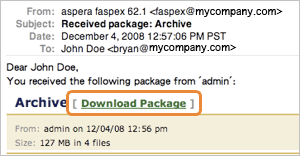
|
When a package is sent to you over faspex, an email notification containing the download link will be sent to your email address. If the email contains the download link, the link will open the package's download page on faspex:
|
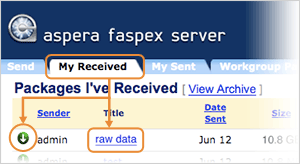
|
To locate the package you have received, log into faspex and go to My Received from the faspex menu to open the package list. You can download the complete package by clicking the  (Download button), or click the package name to advance to the package detail page. (Download button), or click the package name to advance to the package detail page.
In the package detail page, the general items in the page are indicated in the following graph:
|
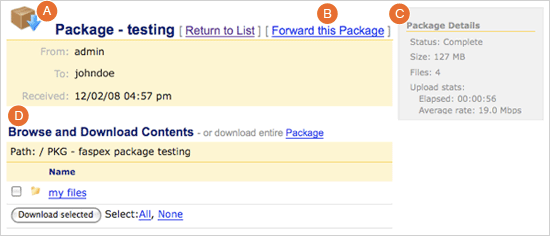
- A Download Icon
-
Click the icon to download the complete package.
- B Forward this Package
-
Click to forward this package to others if your account has proper permission.
- C Details
-
This box shows the package's information and download activity.
- D Browse and
Download Contents
-
Click to navigate into the folders contained in this package, and select individual files, click Download Selected to download only selected files.
5.1.2 Archive Received Packages

|
The files in the packages you have received can be archived by the faspex's expiration settings, the administrators, or by you. In the My Received list, click the Archive to move the files of the corresponding package from the received list into the archive.
|
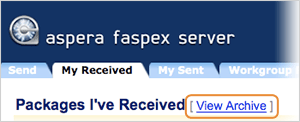
|
To view the log of all packages you have received regardless of the existence of files they contain, click the View Archive from the My Received package listing page.
|
5.1.3 Download Workgroup Packages

|
If you are a member of a faspex workgroup, you can access the workgroup and download its packages. To do so, go to the Workgroups from the faspex menu. Click the workgroup to access.
|
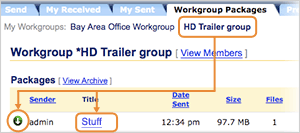
|
In a workgroup, you should see all the workgroup's packages listed in the table. Click the  (Download button) to download the complete file package, or click the package name to go to the package detail page. (Download button) to download the complete file package, or click the package name to go to the package detail page.
|
When clicking the package name from the list, faspex opens the package detail page. General items are indicated below:

- A Download Icon
- Click the icon to download the complete package.
- B Forward this Package
- Click to forward this package to others if your account has proper permission.
- C Details
- This box shows the package's information and download activity.
- D Browse and
Download Contents
- Click to navigate into the folders contained in this package, and select individual files, click Download Selected to download only selected files.

|
In the workgroup package listing page, click View Members to see all the workgroup members.
|

|
If you are an administrator of faspex or a particular workgroup, in the workgroup's package listing page you can click the Archive to move the files of the corresponding package into the archive.
|
5.2 Send Packages

|
To send a file package through faspex, go to Send from the faspex menu.
The following graph shows all options in the Create and send package form. Click Send Package! when finished:
|
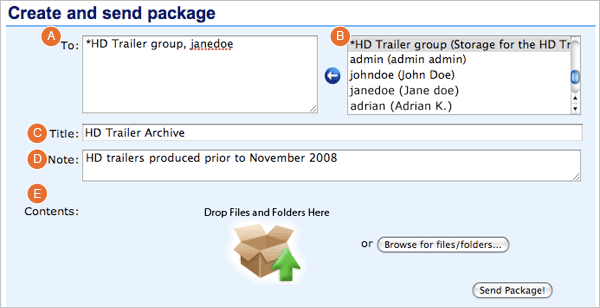
- A To:
- Enter individuals or workgroups as recipients. The workgroup's name starts with an asterisk (*).
- B Recipient List:
- Shows a list of recipient that you can send the packages. You can select the users or workgroups from this list and click
 (Left arrow) to add them as recipients.
(Left arrow) to add them as recipients.
- C Title:
- Enter the package's title.
- D Note:
- Enter the package's note.
- E Contents:
- Drag-and-drop the files to include onto the image, or click Browse for files/folders to browse and select files.

|
To send a file package through faspex, go to Send from the faspex menu.
When a transfer is initiated, faspex will prompt the Aspera Connect to start the session. Click Allow when the confirmation dialog window appear.
|

|
You can access the packages you have sent by going to Sent from the faspex menu. Here you can review the packages you have sent. If a package isn't sent successfully, click  (Resume) to restart the transfer. (Resume) to restart the transfer.
|
Appendix 1. Restart faspex
If faspex is not working properly, it is recommended to restart faspex services. Execute the command to restart all faspex-related services:
- Step 1 Navigate into faspex's directory in Command Prompt
-
Open Command Prompt (Start > All Programs > Accessories > Command Prompt), enter the command to navigate into the faspex directory:
- 32bit XP/2003
-
> cd "C:\Program Files\Aspera\Faspex"
- 64bit XP/2003
-
> cd "C:\Program Files (x86)\Aspera\Faspex"
- Step 2 Restart all faspex services
-
In the faspex directory, execute the command:
> asctl all:restart
If you have Aspera Console installed on the same machine, this command also restarts all Console services.
- Step 1 Navigate into faspex's directory in Command Prompt
-
Use the command to navigate into the faspex directory:
$ cd /opt/aspera/faspex/asctl
- Step 2 Stop all services
-
In the faspex directory, execute the command:
$ ./asctl all:restart
Appendix 2. The Log Files
The Aspera faspex log files are located in the directory:
- 32bit XP/2003
- C:\Program Files\Aspera\Faspex\log
- 64bit XP/2003
- C:\Program Files (x86)\Aspera\Faspex\log
- Linux
- /opt/aspera/faspex/log
In the log directory, faspex's Apache logs into the following files:
- access_log
- error_log
- ssl_access_log
- ssl_error_log
- ssl_request_log
You can further configure the faspex's Apache log using the asctl commands. In terminal, navigate into the directory:
- 32bit XP/2003
- C:\Program Files\Aspera\Faspex\
- 64bit XP/2003
- C:\Program Files (x86)\Aspera\Faspex\
- Linux
- /opt/aspera/faspex/bin
Use the following commands to modify the Apache logging settings. On Linux, replace the command asctl with ./asctl:
- Specify an Apache log level. (e.g. error level)
- $ asctl all:log_level error
- Enable Apache log. (Set to notice)
-
$ asctl all:enable_logs
- Disable Apache log. (Set to emerg level)
-
$ asctl all:disable_logs
- Delete logs older than certain days (e.g. 30 days)
-
$ asctl all:delete_logs_older_than 30
Appendix 3. Reset the faspex Admin Password
If you lost the faspex admin's password, follow these steps to reset it:
- Step 1 Navigate into the faspex directory
-
In Command Prompt (Windows) or Terminal, navigate into the faspex directory:
- 32bit XP/2003
-
> cd "C:\Program Files\Aspera\Faspex"
- 64bit XP/2003
-
> cd "C:\Program Files (x86)\Aspera\Faspex"
- Linux
-
$ cd /opt/aspera/faspex/bin
- Step 2Execute the reset admin password command
-
In the faspex directory, execute the command. On Linux, replace the command asctl with ./asctl:
> asctl faspex:reset_admin_password
Enter the new admin account password when prompted, enter again when prompted for confirmation. When the password is updated successfully, the admin should be able to log in faspex with the new password.
Appendix 4. faspex Commands
You can use the provided commands to control faspex. In Command Prompt (Windows) or Terminal, use the command to navigate into the following directory:
- 32bit XP/2003
-
> cd "C:\Program Files\Aspera\Faspex"
- 64bit XP/2003
-
> cd "C:\Program Files (x86)\Aspera\Faspex"
- Linux
-
$ cd /opt/aspera/faspex/bin
Execute the following to list all options for asctl command. On Linux, replace the command asctl with ./asctl:
$ asctl all:help
You can use the asctl command and the option in the following format:
- faspex-specific
-
$ asctl faspex:option
- All Components (faspex, MySQL, Apache)
-
$ asctl all:option
For example, to display the faspex hostname, use the command:
$ asctl faspex:hostname
Reference
Copyright 2009 © Aspera Inc. All Rights Reserved

 Figure 1.
Figure 1.

































 (Download button), or click the package name to advance to the package detail page.
(Download button), or click the package name to advance to the package detail page.




 (Download button) to download the complete file package, or click the package name to go to the package detail page.
(Download button) to download the complete file package, or click the package name to go to the package detail page.





 (Left arrow) to add them as recipients.
(Left arrow) to add them as recipients.

 (Resume) to restart the transfer.
(Resume) to restart the transfer.